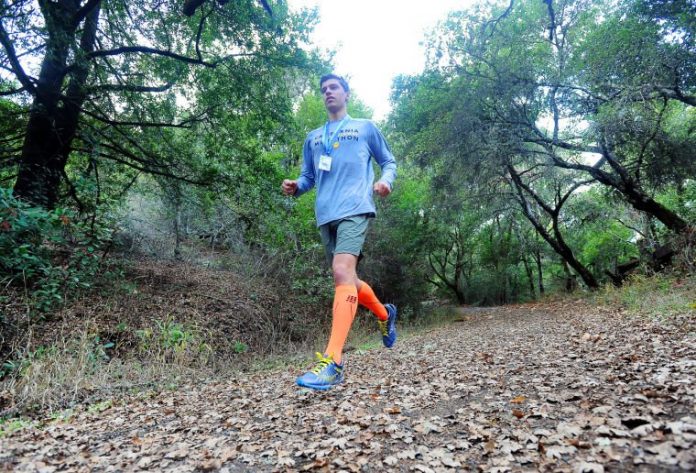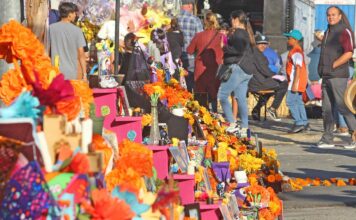
Just over a year ago, Nathan Lynch couldn’t run 400-meters without feeling like he was going to faint.
Though he barely had the energy for anything else, the 17-year-old tried time after time to run, but the effects of his chemotherapy got the best of him.
On Dec. 8, just 11 months after leaving Stanford following his final treatment, Lynch not only completed the California International Marathon, but finished second in his age group with a Boston Marathon qualifying time of 3:04:17 — a symbolic achievement of beating Burkitt Non-Hodgkins Lymphoma.
Looking at Lynch, he looks like your average teenager. He’s tall and slim — the physique of a runner —charismatic and energetic, but modest when speaking of his achievements. Even when talking about his battle with cancer, he doesn’t waiver. In fact, he shows off the scar from where he had his port during chemotherapy as if it were a battle wound.
He’s not far off.
Lynch’s fight with cancer began before he even knew it. The Valley Christian cross country runner was prepping for the Stanford Invitational when he started experiencing severe stomach pain. He spent the entire evening of Sept. 28, 2012 throwing up, only to get up the next morning and run the race for his team — finishing in an impressive time of 19:42 given what he’d been through the night before. The pain and sickness seemed to subside, so the incident was written off as food poisoning.
But two weeks later, it happened again.
Not being one to let a physical ailment stand in his way, Lynch once again pushed the pain aside to run the Clovis Invitational despite losing fluids and sleep the night before. This time, however, the pain didn’t go away. Even when the worst of pains subsided it still lingered and it was then that Lynch knew something was wrong.
On Oct. 14, 2012 Lynch and his family went to Good Samaritan Hospital in San Jose where he received an ultrasound and a mass was discovered. Not knowing what it was, Lynch’s doctors scheduled surgery to remove and test the mass. No one was prepared for the results — Stage 3 Burkitt Non-Hodgkins, or in other words, cancer.
“We were a wreck,” Shauna Lynch, Nathan’s mother said. “You never think that will be a word in your vocabulary, that you’ll use that word and your kid’s name in the same sentence.”
Nathan was then transferred to Stanford where he suffered through five rounds of aggressive chemo, taking punch after punch from the treatment for a week at a time. He was given two weeks to get his blood counts back up and just when he started to feel like himself again, he had to go toe-to-toe with the treatment again.
As chemo goes on, Nathan said it gets more difficult and your body begins to feel beaten down. No matter how hard it got, he remained strong.
“The whole time he was going through this, he never complained about anything,” Nathan’s father Scott Lynch said. “The nurses loved him and you know you’re going to be getting these chemicals and they have to stick you and they’ve got to test you and they’ve got to do all these things — never complained.”
Nathan’s friends, family, teammates and classmates came out in droves to support him. Even when he started to loose his hair from chemo, three of his closest friends shaved their heads with him — he has the video on his iPhone to prove it.
But if you ask Nathan to put his finger on the one thing that got him through his treatment, he can’t do it.
“It’s like 50-100 things,” he said — and one of them being running.
Even though he couldn’t physically be there for his team, he still found a way to be a part of it. Valley Christian coach Josh Small said that Nathan wrote the team letters from the hospital, which in turn made his teammates want to do better in his honor.
“He really was there for the team,” Small said. “He was a leader and he encouraged our team. It’s encouraging to see him go him the lowest low and build back and see what he can accomplish. He really is an inspiration and a model for our team.”
Getting back in the game
As he sat in the hospital bed receiving his treatment, most of the time playing Xbox or watching something on iTunes — thanks to the $500 in iTunes giftcards he jokes about receiving from almost everyone he knows — Nathan thought about running. In fact, he would tell his doctors and nurses that one day he was going to run a marathon.
“When it comes to running, I’m a pretty hard headed person,” Nathan said. “If I set my sights on it, I’m going to do it. It (cancer) wasn’t that discouraging, I knew I’d get back to it sometime. The only thing that was kind of frustrating was I couldn’t do it during (chemo). I just had to look forward to doing it after. It took an insane amount of patience — which I don’t always have.”
The day after he was released from Stanford, Jan. 12, 2013, Nathan started running again. At first, it was a quarter mile, then a half mile. By the two week point, he was up to a mile and a half. He wasn’t anticipating doing track at all that season, but the Gilroy runner was able to make his return with four meets left — include the West Catholic Athletic League Championships in which he finished the two mile in 10:40.
After that, he began training for his junior cross country season, running 10 miles a day — 70 a week — with a rest day in between. The training paid off as Nathan broke record after record at Valley Christian. But the thought of running a marathon still lingered in his mind.
As a cancer survivor, he would gain free admission to Nike marathons, so he figured now was as good a time as any to run one. But not just run — that would’ve been a piece of cake — he wanted to race and meet the Boston Marathon qualifying time of 3:05:00.
Three months before the race his Small gave him his training program — which consisted of alternating long runs, long tempo runs and a track workout for pace — in which he ran 98-mile weeks at certain points.
“He’s a very determined young man and he’s focused,” Small said. “He really did the majority of it by himself. He was out there focusing on the goal.”
Nathan would come home from his training runs with mud up to his ankles after running trails in Morgan Hill or on the Los Gatos Creek Trail. His workouts gradually dwindled down to a mere 8-mile run the week before the marathon in order to allow his body to prepare for what it was about to endure.
Race day
The conditions for the CIM couldn’t have been more perfect. It was clear and cold in Sacramento, about 24 degrees, which is exactly what you want when you’re about to run long distances, Nathan said. The cold, however, does get to you.
Nathan ran with a half-full water bottle, which after months of training, he knew would last him until Mile 13. He took a sip at every mile as well as a bite of food — something he had trained himself to do. It was only when he had to refill his water that he ran into problems.
Not many can run and refill their water bottle gracefully and such was the case with Nathan. As he refilled, he spilled water all over his gloves causing his already cold hands to freeze up. By Mile 22, the gloves were so uncomfortable that Nathan decided to run bare handed instead. Otherwise the miles passed with ease and he didn’t even look at his watch until an hour and 15 minutes had passed. It was smooth sailing until Mile 20 — also known as “The Wall”.
“You just go and you don’t think. It’s just right foot over left,” Nathan said noting that at Mile 19 he started to feel a knot develop behind his knee. “I just told myself ‘I’m not going to hurt until (Mile) 25. I’m not going to let myself hurt until 25’.”
Nathan pushed through the pain, praying his way to the finish line, reaching his goal of qualifying for the Boston Marathon. Those few minutes after crossing the finishing were hectic as he wrapped himself in a thermal blanket for warmth, posed for photo in front of CIM backdrop and then scrambled to find his parents and 13-year-old sister Abbey, who he had lost in the madness.
“It was just amazing seeing him come around the corner,” Shauna said with tears welling up in her eyes. “He did it; He reached his goal.”
Nathan didn’t want to stay and enjoy the marathon’s after party, he could barely fight back the tears as it was. Never before had he felt the pain he did that day and the gratification didn’t set in until much later when he was fed, warm and relaxed.
“It’s (the pain) one of those things where you absolutely have to do it to understand what it feels like,” Nathan said. “I can give you an idea — it’s five months of chemo jammed into three hours.”
Moving forward
The new year will be a busy one for Nathan as he preps for his junior track season with Valley Christian, trains for the 2015 Boston Marathon and runs cross country in the fall — all while juggling school work. But for him, this is paradise.
“It’s (running) one of the biggest releases — it’s almost like you’re going on vacation every single day,” Nathan said. “You get that hour and a half to two hours to yourself. You just go, you zone out and you think about whatever you want to think about.”
Successfully entering remission means the likelihood of relapse is extremely rare. A year after completion, Nathan said, the chances are slim to none and if he is diagnosed with cancer in the future it will be completely unrelated. His chances of developing cancer have increased since he’s already had it and that, he said, can be a little daunting for a 17-year-old.
“Whenever I get little stomach aches here or there it kind of worries me a little bit,” he said. “The worry is less and less as time wares on.”
In spite of everything — the pain, the long days of treatment and the physical stress — Nathan said he wouldn’t change a thing. Having cancer and beating it have made him the person he is today, further proving that if there’s a will, there’s a way.
“You find a way to get through it, just like any other obstacle in life. Most people look at it as ‘That really sucks, it was a total setback’, but it was a pretty awesome experience,” Nathan said. “It was something that I definitely benefited going through and it taught me a lot. Strength-wise I’ve always had that mindset where if I want to do something, it will freakin’ happen — whether it’s physical, good or bad. Physical boundaries, I push them and any obstacle, I walk over it — I really push my limits.”












